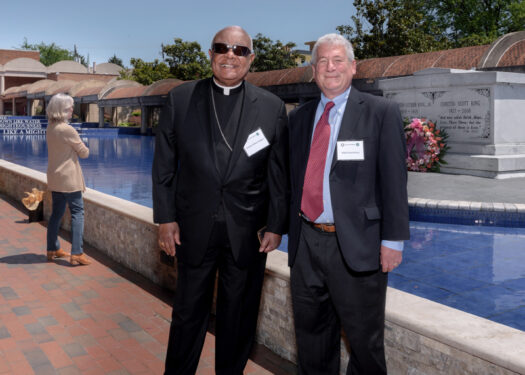
By Samantha Smith
ATLANTA (CNS) — Leaders of the Catholic and Jewish faith communities gathered for fellowship and to find ways to heal the hatred of racism in a three-day journey to civil rights landmarks.
From May 9-11, representatives of the National Council of Synagogues and U.S. Conference of Catholic Bishops and other leaders met to discuss the history and impact of racism in society, their respective faiths and to find solutions to create a better world.
The journey began in Atlanta, with stops at the Lyke House Catholic Center located at the Historically Black College and Universities in Atlanta’s West End and the Martin Luther King Jr. Historic Site. It concluded in Alabama, with visits to historic sites in Birmingham, Selma and Montgomery.
Co-chairs of the dialogue between the National Council of Synagogues and the USCCB are Cardinal Wilton D. Gregory of Washington, and Rabbi David Straus, executive director of the National Council of Synagogues.
This was the cardinal’s first visit to Atlanta since being installed as Washington’s archbishop in 2019. The following year, he was elevated to cardinal by Pope Francis. He was Atlanta’s archbishop from 2005 until Pope Francis appointed him to head the Washington Archdiocese.
“It feels like coming home,” said Cardinal Gregory on his return.
According to its website, the National Council of Synagogues is a partnership of the Reform, Conservative and Reconstructionist movements in Judaism dealing with interreligious affairs on a national level. The council believes religions should dialogue with one another to build a better society and world.
A goal for this group and its three-day event is to create a high school curriculum for Catholic and Jewish schools to learn about one another’s faith traditions and explore the issues of racism in America.
Cardinal Gregory has been active in Catholic-Jewish dialogue for many decades. He is a former chairman of the USCCB’s Committee on Ecumenical and Interreligious Affairs.
His work includes the Atlanta Archdiocese’s 2015 jubilee celebration of “Nostra Aetate” — the 1965 Declaration on the Relationship of the Church to Non-Christian Religions — and the annual follow-up events that encouraged discussion and fellowship between the Catholic and Jewish faith traditions.
“Nostra Aetate” was the Second Vatican Council document that transformed the church’s approach to Judaism after centuries of troubled relations.
“We are so divided as a society — racially divided, religiously divided, politically divided,” said Cardinal Gregory. “We need to take whatever opportunities come our way to work together as an example of how people should be neighbors, friends, brothers and sisters.”
Interreligious and interfaith dialogue have been a passion for Rabbi Straus, who has been executive director of the National Council of Synagogues for about eight years.
“When you get seriously engaged in this work, you not only learn about other people of faith and what they believe and how they live their lives,” said Rabbi Straus. “But it forces you to really look inward at your own faith tradition. And I think it actually strengthens your faith and strengthens your commitment because you have to ask really important questions.”
The meeting began at Lyke House, which serves students from Morehouse College, Spelman College, Clark Atlanta University and Georgia State University. Council members were greeted by student ambassadors from Our Lady of Mercy High School in Fayetteville, Georgia.
After lunch, members were able to tour the Lyke House gallery, which honors the late Archbishop James P. Lyke of Atlanta and the history and contributions of Black Catholics.
“We’re here in a facility that is dedicated to the formation and education of young people,” said Cardinal Gregory. “Anytime our young people can reach out across religious, cultural, language differences, it bodes very well for our future.”
The first day concluded with a visit to the Martin Luther King Jr. Historical Park, which included the King Center, the crypt of the Rev. King and Coretta Scott King, and the original and new Ebenezer Baptist churches.
After a day of meetings and reports, the council began their journey to Alabama, where members visited the 16th Street Baptist Church in Birmingham and the Edmund Pettus Bridge in Selma.
In Montgomery, the council visited the Rosa Parks Museum, the Legacy Museum and the National Memorial for Peace and Justice by Equal Justice Initiative.
To be able to spend three days together and share an incredibly powerful experience is an extraordinary opportunity, said Rabbi Straus.
Smith is a staff writer at The Georgia Bulletin, newspaper of the Archdiocese of Atlanta.
